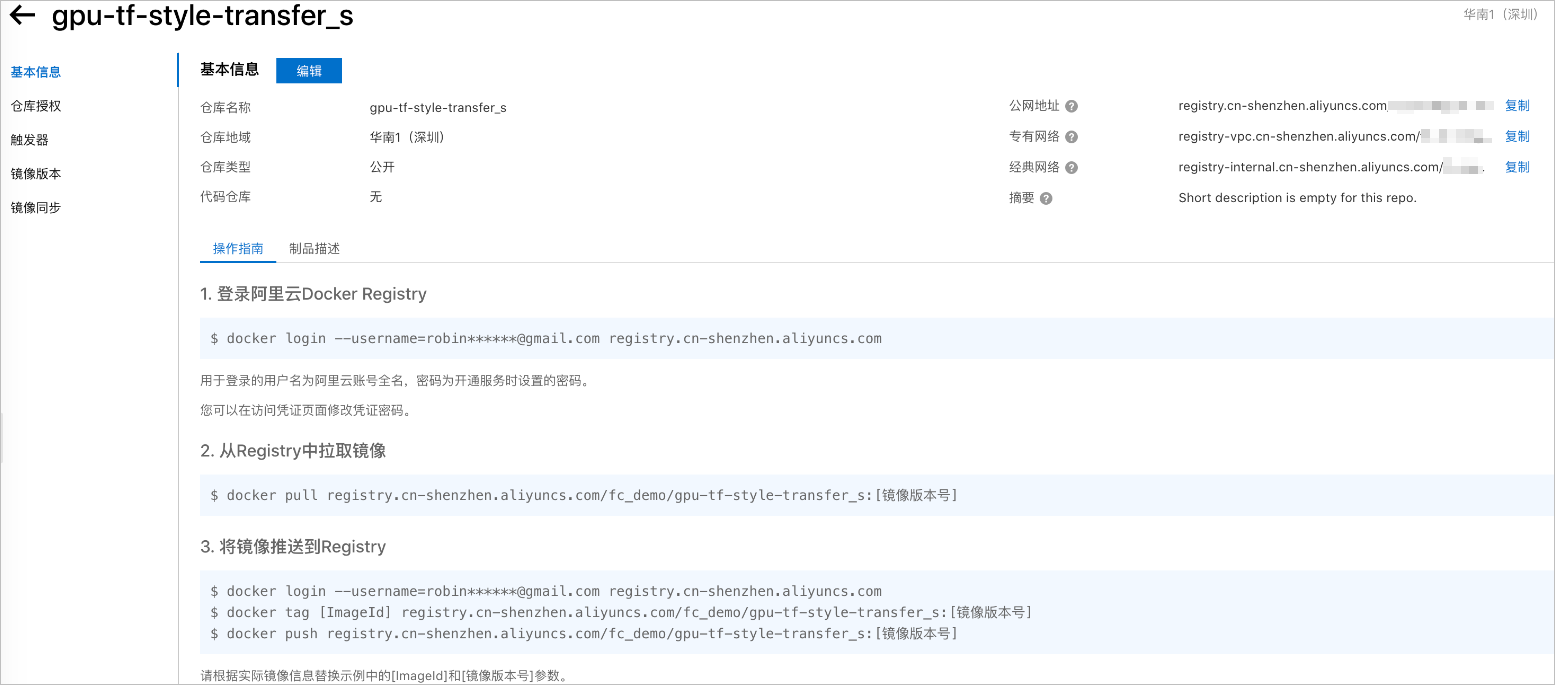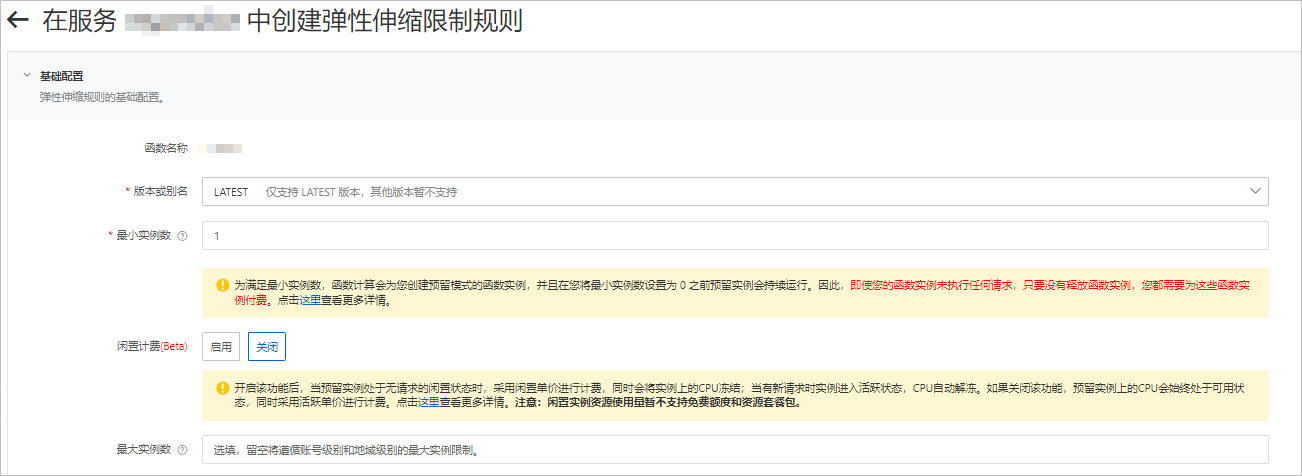您可以通过函数计算控制台、SDK或Serverless Devs来体验GPU实例的最佳实践。本文以Python语言为例,说明如何使用Serverless Devs开发工具,将原始视频经过函数代码的转码处理,从.mp4转换为.flv格式。
应用场景和优势
随着越来越多的强交互应用场景的出现,例如社交直播、在线课堂以及远程医疗等,互联网流量正在向实时、准实时的趋势演进。视频平台通常要将原始视频内容根据码率、分辨率、渠道贴片、播放平台等维度,以1∶N的方式转码输出多种分发视频格式,以服务不同网络质量、各种播放平台的观看者。视频转码是视频生产分发中的关键一环,理想的视频转码解决方案需要在成本(人民币/流)和功率效率(瓦/流)方面具有成本效益。
在不同的应用场景下,函数计算提供的GPU实例与CPU相比所具备的优势如下。
实时、准实时的应用场景
提供数倍于CPU的转码效率,从而快速将生产内容推向终端用户。
成本优先的GPU应用场景
提供弹性预留模式,从而按需为您保留工作GPU实例,对比自购VM拥有较大成本优势。
效率优先的GPU应用场景
屏蔽运维GPU集群的繁重负担(驱动/CUDA版本管理、机器运行管理、GPU坏卡管理),使得开发者专注于代码开发、聚焦业务目标的达成。
GPU实例的更多信息,请参见实例类型及使用模式。
性能对比
函数计算GPU实例基于的Turing架构支持以下编码和解码格式:
编码格式
H.264 (AVCHD) YUV 4:2:0
H.264 (AVCHD) YUV 4:4:4
H.264 (AVCHD) Lossless
H.265 (HEVC) 4K YUV 4:2:0
H.265 (HEVC) 4K YUV 4:4:4
H.265 (HEVC) 4K Lossless
H.265 (HEVC) 8k
HEVC10-bitsupport
HEVCB Framesupport
解码格式
MPEG-1
MPEG-2
VC-1
VP8
VP9
H.264 (AVCHD)
H.265 (HEVC) 4:2:0
*H.265 (HEVC) 4:4:4
8 bit
10 bit
12 bit
8 bit
10 bit
12 bit
8 bit
10 bit
12 bit
原始视频信息如下表所示。
视频信息 | 数据 |
时长 | 2分05秒 |
码率 | 4085 Kb/s |
视频流信息 | h264 (High), yuv420p (progressive), 1920x1080 [SAR 1:1 DAR 16:9], 25 fps, 25 tbr, 1k tbn, 50 tbc |
音视频信息 | aac (LC), 44100 Hz, stereo, fltp |
CPU和GPU的测试机器指标如下表所示。
对比项 | CPU机型 | GPU机型 |
CPU | CPU Xeon® Platinum 8163 4C | CPU Xeon® Platinum 8163 4C |
RAM | 16 GB | 16 GB |
GPU | N/A | T4 |
FFmpeg | git-2020-08-12-1201687 | git-2020-08-12-1201687 |
视频转码(1∶1)
性能测试:1路输入、1路输出
分辨率 | CPU转码耗时 | GPU转码耗时 |
H264∶1920x1080 (1080p) (Full HD) | 3分19.331秒 | 0分9.399秒 |
H264∶1280x720 (720p) (Half HD) | 2分3.708秒 | 0分5.791秒 |
H264∶640x480 (480p) | 1分1.018秒 | 0分5.753秒 |
H264∶480x360 (360p) | 44.376秒 | 0分5.749秒 |
视频转码(1∶N)
性能测试:1路输入、3路输出
分辨率 | CPU转码耗时 | GPU转码耗时 |
H264∶1920x1080 (1080p) (Full HD) | 5分58.696秒 | 0分45.268秒 |
H264∶1280x720 (720p) (Half HD) | ||
H264∶640x480 (480p) |
转码命令
CPU转码命令
单路转码(1∶1)
docker run --rm -it --volume $PWD:/workspace --runtime=nvidia willprice/nvidia-ffmpeg -y -i input.mp4 -c:v h264 -vf scale=1920:1080 -b:v 5M output.mp4多路转码(1∶N)
docker run --rm -it --volume $PWD:/workspace --runtime=nvidia willprice/nvidia-ffmpeg \ -y -i input.mp4 \ -c:a copy -c:v h264 -vf scale=1920:1080 -b:v 5M output_1080.mp4 \ -c:a copy -c:v h264 -vf scale=1280:720 -b:v 5M output_720.mp4 \ -c:a copy -c:v h264 -vf scale=640:480 -b:v 5M output_480.mp4
表 1. 参数说明 参数
说明
-c:a copy
无需任何重新编码即可复制音频流。
-c:v h264
为输出流选择软件H.264编码器。
-b:v 5M
将输出比特率设置为5 Mb/s。
GPU转码命令
单路转码(1∶1)
docker run --rm -it --volume $PWD:/workspace --runtime=nvidia willprice/nvidia-ffmpeg -y -hwaccel cuda -hwaccel_output_format cuda -i input.mp4 -c:v h264_nvenc -vf scale_cuda=1920:1080:1:4 -b:v 5M output.mp4多路转码(1∶N)
docker run --rm -it --volume $PWD:/workspace --runtime=nvidia willprice/nvidia-ffmpeg \ -y -hwaccel cuda -hwaccel_output_format cuda -i input.mp4 \ -c:a copy -c:v h264_nvenc -vf scale_npp=1920:1080 -b:v 5M output_1080.mp4 \ -c:a copy -c:v h264_nvenc -vf scale_npp=1280:720 -b:v 5M output_720.mp4 \ -c:a copy -c:v h264_nvenc -vf scale_npp=640:480 -b:v 5M output_480.mp4
表 2. 参数说明 参数
说明
-hwaccel cuda
选择合适的硬件加速器。
-hwaccel_output_format cuda
将解码的帧保存在GPU内存中。
-c:v h264_nvenc
选择NVIDIA硬件加速H.264编码器。
准备工作
- 为了确保您的业务正常进行,请加入钉钉用户群(钉钉群号:11721331),申请GPU实例的使用权限,同时提供以下信息。
- 组织名称,例如您所在的公司名称。
- 您的阿里云账号ID。
- 您期望使用GPU实例的地域,例如华南1(深圳)。
- 联系方式,例如您的手机号、邮箱或钉钉账号等。
- 您的镜像大小。
- 在GPU实例所在地域,完成以下操作:
- 创建容器镜像服务的企业版实例或个人版实例,推荐您创建企业版实例。具体操作步骤,请参见创建企业版实例。
- 创建命名空间镜像仓库。具体操作步骤,请参见步骤二:创建命名空间和步骤三:创建镜像仓库。
- 编译FFmpeg。
FFmpeg需要自行编译以使用GPU加速,编译方式如下:
- (推荐)通过Docker使用已编译好的FFmpeg。下载地址:nvidia-ffmpeg或ffmpeg
- 自行编译。具体步骤,请参见官网编译手册。
- 将需处理的音视频资源上传至在GPU实例所在地域的OSS Bucket中,且您对该Bucket中的文件有读写权限。具体步骤,请参见控制台上传文件。权限相关说明,请参见修改存储空间读写权限。
通过Serverless Devs部署GPU应用
前提条件
操作步骤
- 创建项目。
s init devsapp/start-fc-custom-container-event-python3.9 -d fc-gpu-prj创建的项目目录如下所示。
fc-gpu-prj ├── code │ ├── app.py # 函数代码 │ └── Dockerfile # Dockerfile:将代码打包成镜像的Dockerfile ├── README.md └── s.yaml # 项目配置:包含了镜像如何部署在函数计算 - 进入项目所在目录。
cd fc-gpu-prj 按实际情况修改目录文件的参数配置。
编辑s.yaml文件。
YAML文件的参数详解,请参见YAML规范。
edition: 1.0.0 name: container-demo access: default vars: region: cn-shenzhen services: customContainer-demo: component: devsapp/fc props: region: ${vars.region} service: name: tgpu_ffmpeg_service internetAccess: true function: name: tgpu_ffmpeg_func description: test gpu for ffmpeg handler: not-used timeout: 600 caPort: 9000 instanceType: fc.gpu.tesla.1 gpuMemorySize: 8192 cpu: 4 memorySize: 16384 diskSize: 512 runtime: custom-container customContainerConfig: # 1. 请检查阿里云ACR容器镜像仓库已提前创建相应的命名空间(namespace:demo)与仓库(repo:gpu-transcoding_s)。 # 2. 后续更新函数时,请修改此处的tag,由v0.1修改为v0.2后,重新执行s build && s deploy。 image: registry.cn-shanghai.aliyuncs.com/demo/gpu-transcoding_s:v0.1 codeUri: ./code编辑app.py文件。
示例如下:
# -*- coding: utf-8 -*- # python2 and python3 from __future__ import print_function from http.server import HTTPServer, BaseHTTPRequestHandler import json import sys import logging import os import time import urllib.request import subprocess class Resquest(BaseHTTPRequestHandler): def download(self, url, path): print("enter download:", url) f = urllib.request.urlopen(url) with open(path, "wb") as local_file: local_file.write(f.read()) def upload(self, url, path): print("enter upload:", url) headers = { 'Content-Type': 'application/octet-stream', 'Content-Length': os.stat(path).st_size, } req = urllib.request.Request(url, open(path, 'rb'), headers=headers, method='PUT') urllib.request.urlopen(req) def trans(self, input_path, output_path, enable_gpu): print("enter trans input:", input_path, " output:", output_path, " enable_gpu:", enable_gpu) cmd = ['ffmpeg', '-y', '-i', input_path, "-c:a", "copy", "-c:v", "h264", "-b:v", "5M", output_path] if enable_gpu: cmd = ["ffmpeg", "-y", "-hwaccel", "cuda", "-hwaccel_output_format", "cuda", "-i", input_path, "-c:v", "h264_nvenc", "-b:v", "5M", output_path] try: subprocess.run(cmd, stdout=subprocess.PIPE, stderr=subprocess.PIPE, check=True) except subprocess.CalledProcessError as exc: print('\nreturncode:{}'.format(exc.returncode)) print('\ncmd:{}'.format(exc.cmd)) print('\noutput:{}'.format(exc.output)) print('\nstderr:{}'.format(exc.stderr)) print('\nstdout:{}'.format(exc.stdout)) def trans_wrapper(self, enable_gpu): src_url = "https://your.domain/input.mp4" # 需替换为您个人阿里云账号下的OSS,且您有可读写的权限。 dst_url = "https://your.domain/output.flv" # 需替换为您个人阿里云账号下的OSS,且您有可读写的权限。 src_path = "/tmp/input_c.flv" dst_path = "/tmp/output_c.mp4" if enable_gpu: src_url = "https://your.domain/input.mp4" # 需替换为您个人账号下的OSS,且您有可读写的权限。 dst_url = "https://your.domain/output.flv" # 需替换为您个人账号下的OSS,且您有可读写的权限。 src_path = "/tmp/input_g.flv" dst_path = "/tmp/output_g.mp4" local_time = time.time() self.download(src_url, src_path) download_time = time.time() - local_time local_time = time.time() self.trans(src_path, dst_path, enable_gpu) trans_time = time.time() - local_time local_time = time.time() self.upload(dst_url, dst_path) upload_time = time.time() - local_time data = {'result':'ok', 'download_time':download_time, 'trans_time':trans_time, 'upload_time':upload_time} self.send_response(200) self.send_header('Content-type', 'application/json') self.end_headers() self.wfile.write(json.dumps(data).encode()) def pong(self): data = {"function":"trans_gpu"} self.send_response(200) self.send_header('Content-type', 'application/json') self.end_headers() self.wfile.write(json.dumps(data).encode()) def dispatch(self): mode = self.headers.get('TRANS-MODE') if mode == "ping": self.pong() elif mode == "gpu": self.trans_wrapper(True) elif mode == "cpu": self.trans_wrapper(False) else: self.pong() def do_GET(self): self.dispatch() def do_POST(self): self.dispatch() if __name__ == '__main__': host = ('0.0.0.0', 9000) server = HTTPServer(host, Resquest) print("Starting server, listen at: %s:%s" % host) server.serve_forever()编辑Dockerfile文件。
示例如下:
FROM registry.cn-shanghai.aliyuncs.com/serverless_devs/nvidia-ffmpeg:latest WORKDIR /usr/src/app RUN apt-get update --fix-missing RUN apt-get install -y python3 RUN apt-get install -y python3-pip COPY . . ENTRYPOINT [ "python3", "-u", "/usr/src/app/app.py" ] EXPOSE 9000
- 构建镜像。
s build --dockerfile ./code/Dockerfile - 部署代码至函数计算。
s deploy说明 服务名称和函数名称不变,重复执行以上命令时,请选择本地配置,即use local。 - 配置预留模式的实例。
s provision put --target 1 --qualifier LATEST 查询预留模式的实例是否就绪。
s provision get --qualifier LATEST如果查询到
current参数为1,则说明GPU实例的预留模式已就绪,示例如下。[2021-12-14 08:45:24] [INFO] [S-CLI] - Start ... [2021-12-14 08:45:24] [INFO] [FC] - Getting provision: tgpu_ffmpeg_service.LATEST/tgpu_ffmpeg_func customContainer-demo: serviceName: tgpu_ffmpeg_service functionName: tgpu_ffmpeg_func qualifier: LATEST resource: 188077086902****#tgpu_ffmpeg_service#LATEST#tgpu_ffmpeg_func target: 1 current: 1 scheduledActions: (empty array) targetTrackingPolicies: (empty array) currentError:调用函数。
查看线上函数版本
s invoke使用CPU进行转码
s invoke -e '{"method":"GET","headers":{"TRANS-MODE":"cpu"}}'使用GPU进行转码
s invoke -e '{"method":"GET","headers":{"TRANS-MODE":"gpu"}}'
- 释放GPU实例。
s provision put --target 0 --qualifier LATEST
通过函数计算控制台部署GPU应用
- 部署镜像。
- 建容器镜像服务的企业版实例或个人版实例。推荐您创建企业版实例。具体操作步骤,请参见创建企业版实例。
- 创建命名空间和镜像仓库。具体操作步骤,请参见步骤二:创建命名空间和步骤三:创建镜像仓库。
- 在容器镜像服务控制台,根据界面提示完成Docker相关操作步骤。然后将上述示例app.py和Dockerfile推送至实例镜像仓库,文件信息,请参见通过ServerlessDevs部署GPU应用时/code目录中的app.py和Dockerfile。

- 建容器镜像服务的企业版实例或个人版实例。
- 创建服务。具体操作步骤,请参见创建服务。
- 创建函数。具体操作步骤,请参见创建Custom Container函数。说明 实例类型选择GPU实例,请求处理程序类型选择处理 HTTP 请求。
修改函数的执行超时时间。
单击目标服务下目标函数右侧操作列的配置。
在环境信息区域,修改执行超时时间,然后单击保存。

说明CPU转码耗时会超过默认的60s,因此建议您修改执行超时时间为较大的值。
配置GPU预留实例。
在函数详情页面,单击弹性管理页签,然后单击创建规则。
在创建弹性伸缩限制规则页面,按需配置参数,预留GPU实例,然后单击创建。
关于配置预留实例的具体操作,请参见配置预留实例。

配置完成后,您可以在规则列表查看预留的GPU实例是否就绪。即当前预留实例数是否为设置的预留实例数。
使用cURL测试函数。
在函数详情页面,单击触发器管理页签,查看触发器的配置信息,获取触发器的访问地址。
在命令行执行如下命令,调用GPU函数。
查看线上函数版本
curl -v "https://tgpu-ff-console-tgpu-ff-console-ajezot****.cn-shenzhen.fcapp.run" {"function": "trans_gpu"}使用CPU进行转码
curl "https://tgpu-ff-console-tgpu-ff-console-ajezot****.cn-shenzhen.fcapp.run" -H 'TRANS-MODE: cpu' {"result": "ok", "upload_time": 8.75510573387146, "download_time": 4.910430669784546, "trans_time": 105.37688875198364}使用GPU进行转码
curl "https://tgpu-ff-console-tgpu-ff-console-ajezotchpx.cn-shenzhen.fcapp.run" -H 'TRANS-MODE: gpu' {"result": "ok", "upload_time": 8.313958644866943, "download_time": 5.096682548522949, "trans_time": 8.72346019744873}
执行结果
您可通过在浏览器中访问以下域名,查看转码后的视频:
https://cri-zbtsehbrr8******-registry.oss-cn-shenzhen.aliyuncs.com/output.flv本域名仅为示例,需以实际情况为准。